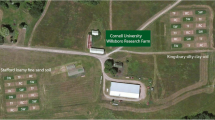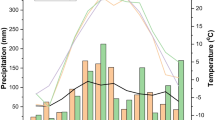Abstract
Switchgrass (Panicum virgatum L.) is well suited to marginal croplands, but is difficult to manage sustainably both for maximum yield and optimal biomass composition. Quality can be improved by overwintering switchgrass in the field, but more information is needed on amount and consistency of yield recovery in spring. Two cultivars of switchgrass were sown on separate fields in Freeville, NY, and mowed and baled in late fall (FALL), mowed in fall and baled in spring (WINTER), or mowed and baled in spring (SPRING), using conventional field harvesting equipment. Samples were collected for analysis of plant morphological components and for determining the influence of harvest stubble height on yield and composition. Recovery of FALL biomass yields the following spring ranged from 52 to 82% and was related to both total winter snowfall and to the spring date when soil was dry enough to allow equipment traffic. Approximately 1% of dry matter yield was left in the field for each centimeter of stubble height following mowing. Bale moisture content was very low in spring, averaging 7.3%, but was much more variable and higher in the fall, averaging 22% for “Cave-in-Rock”. Inflorescence and leaf blade were the primary morphological components lost in standing switchgrass over winter. The SPRING treatment can be mowed and baled on the same day without other field operations and has higher quality than WINTER, with no consistent yield advantage for either spring baling treatment. The large and variable yield loss due to overwintering switchgrass in the field makes the practice questionable.






Similar content being viewed by others
References
Mitchell RB, Schmer MR, Anderson WF, Jin V, Balkcom KS, Kiniry J, Coffin A, White P (2016) Dedicated energy crops and crop residues for bioenergy feedstocks in the central and eastern USA. Bioenergy Res 9:384–398
Casler MR, Sosa S, Hofmann L, Mayton H, Ernst C, Adler P, Boe AR, Bonos SA (2017) Biomass yield of switchgrass cultivars under high- vs. low-input conditions. Crop Sci 57:821–832. https://doi.org/10.2135/cropsci2016.08.0698
Stoof CR, Richards BK, Woodbury PB, Fabio ES, Brumbach A, Cherney JH, Das S, Geohring L, Hansen J, Hornesky J, Mayton H, Mason C, Ruestow G, Smart LB, Volk TA, Steenhuis TS (2015) Untapped potential: opportunities and challenges for sustainable bioenergy production from marginal lands in New York and the Northeast USA. BioEnergy Res 8:482–501
Nilsson D, Rosenqvistm H, Bernesson S (2015) Profitability of the production of energy grasses on marginal agricultural land in Sweden. Biomass Bioenergy 83:159–168
Soldatos P (2015) Economic aspects of bioenergy production from perennial grasses in marginal lands of South Europe. Bioenergy Res 8:1562–1573
Boyer CN, Giffith AP, McIntosh DW, Bates GE, Keyser PD, English BC (2015) Breakeven price of biomass from switchgrass, big bluestem, and Indiangrass in a dual-purpose production system in Tennessee. Biomass Bioenergy 83:284–289
Casler MD, Boe AR (2003) Cultivar x environment interactions in switchgrass. Crop Sci 43:2226–2233
Wilson DM, Dalluge DL, Rover M, Heaton EA, Brown RC (2013) Crop management impacts biofuel quality: influence of switchgrass harvest time on yield, nitrogen and ash of fast pyrolysis products. Bioenergy Res 6:103–113
Fu HM, Meng FY, Molatudi RL, Zhang BG (2016) Sorghum and switchgrass as biofuel feedstocks on marginal lands in northern China. Bioenergy Res 9:633–642
Goel K, Eisner R, Sherson G, Radiotis T, Li J (2000) Switchgrass: a potential pulp fibre source. Pulp Paper-Canada 101:41–47
Johnson JMF, Gresham GL (2014) Do yield and quality of big bluestem and switchgrass feedstock decline over winter? Bioenergy Res 7:68–77
Serapiglia MJ, Boateng AA, Lee DK, Casler MD (2016) Switchgrass harvest time management can impact biomass yield and nutrient content. Crop Sci 56:1–11
Tahir MHN, Casler MD, Moore KJ, Brummer EC (2011) Biomass yield and quality of reed canarygrass under five harvest management systems for bioenergy production. Bioenergy Res 4:111–119
Gorlitsky LE, Sadeghpour A, Hashemi M, Etemadi F, Herbert SJ (2015) Biomass vs. quality tradeoffs for switchgrass in response to fall harvesting period. Ind Crop Prod 63:311–315
Adler PR, Sanderson MA, Boateng AA, Weimer PJ, Jung H-JG (2006) Biomass yield and biofuel quality of switchgrass harvested in fall or spring. Agron J 98:1518–1525
Gamble JD, Jungers JM, Wyse DL, Johnson GA, Lamb JA, Sheaffer CC (2015) Harvest date effects on biomass yield, moisture content, mineral concentration, and mineral export in switchgrass and native polycultures managed for bioenergy. Bioenergy Res 8:740–749
Burval J (1997) Influence of harvest time and soil type on fuel quality in reed canary grass (Phalaris arundinacea L.) Biomass Bioenergy 12:149–154
Kludze H, Deen B, Dutta A (2013) Impact of agronomic treatments on fuel characteristics of herbaceous biomass for combustion. Fuel Process Technol 109:96–102
Landström S, Lomakka L, Andersson S (1996) Harvest in spring improves yield and quality of reed canary grass as a bioenergy crop. Biomass Bioenergy 11:333–341
Serapiglia MJ, Mullen CA, Boateng AA, Cortese LM, Bonos SA, Hoffman L (2015) Evaluation of the impact of compositional differences in switchgrass genotypes on pyrolysis product yield. Ind Crop Prod 74:957–968
Serapiglia MJ, Mullen CA, Boateng AA, Dien BS, Casler MD (2017) Impact of harvest time and cultivar on conversion of switchgrass to bio-oils via fast pyrolysis. Bioenergy Res 10:388–399. https://doi.org/10.1007/s12155-016-9812-5
Williams CL, Westover TL, Emerson EM, Tumuluru JS, Li C (2016) Sources of biomass feedstock variability and the potential impact on biofuels production. Bioenergy Res 9:1–14
Cherney JH, Ketterings Q, Cherney DJR (2016) Soil contamination of grass biomass hay: measurements and implications. Bioenergy Res 9:773–781
Samson R, Bailey-Stamler S, Ho Lem, C (2008) Optimization of switchgrass management for commercial fuel pellet production. Final report prepared by REAP-Canada for the Ontario Ministry of Food, Agric. and Rural Affairs (OMAFRA), Alternative Renewable Fuels Research and Development Fund. Guelph, Ontario, CAN
Cherney JH, Volenec JJ, Nyquist WE (1985) Sequential fiber analysis of forage as influenced by sample weight. Crop Sci 25:1113–1115
Little RC, Milliken GA, Stroup WW, Russell RD (1996) SAS system for mixed models. SAS Institute, Cary
Shinners KJ, Boettcher GC, Muck RE, Wiemer PJ, Casler MD (2006) Drying, harvesting and storage characteristics of perennial grasses as biomass feedstocks. ASABE Paper Number 061012, 19 pp, 9–12 July, 2006, Portland, OR, USA
Cherney JH, Kettering QK, Davis M, Cherney DJR, Paddock KM (2017) Management of warm- and cool-season grasses for biomass on marginal lands: I. Yield and soil fertility status. Bioenergy Res. https://doi.org/10.1007/s12155-017-9869-9
Jannasch R, Duxbury P, Samson R (2001) Development of bioenergy feedstocks: agronomy data from Eastern Canada. REAP-Canada final report to Natural Resources Canada, Ottawa, Ontario, Contract #23384–005068/001/SQ, 28 pp
Girouard P, Samson R (1997) Evaluation of haymaking equipment to harvest switchgrass/part II. REAP-Canada internal report, Ste-Anne-de-Bellevue, 12 pp
Jenkins BM, Bakker RR, Wei JB (1995) On the properties of washed straw. Biomass Bioenergy 10:177–200
Ogden C, Ileleji K, Johnson K (2010) In-field direct combustion fuel property changes of switchgrass harvested from summer to fall. Fuel Process Technol 91:266–271
Cherney JH, Verma VK (2013) Grass pellet quality index: a tool to evaluate suitability of grass pellets for small scale combustion systems. Appl Energy 103:679–684
Cherney, JH, Kettering, QK, Davis, M, Cherney, DJR, Paddock KM (2017) Management of warm- and cool-season grasses for biomass on marginal lands: II. Composition and nutrient balance. Bioenergy Res. https://doi.org/10.1007/s12155-017-9870-3
Cherney DJR, Cherney JH (2005) Forage yield and quality of temperate perennial grasses as influenced by stubble height. Online Forage Grazinglands. https://doi.org/10.1094/FG-2005-0215-01-RS
Cherney JH, Ketterings QM, Orloski JL (2004) Plant and soil elemental status as influenced by multi-year nitrogen and potassium fertilization. J Plant Nutr 27:991–1014
Acknowledgements
This work was supported by the USDA National Institute of Food and Agriculture, Multistate Project 218756. Any opinions, findings, conclusions, or recommendations expressed in this publication are those of the authors and do not necessarily reflect the view of the National Institute of Food and Agriculture (NIFA) or the United States Department of Agriculture (USDA).
Author information
Authors and Affiliations
Corresponding author
Rights and permissions
About this article
Cite this article
Cherney, J.H., Cherney, D.J.R. & Paddock, K.M. Biomass Yield and Composition of Switchgrass Bales on Marginal Land as Influenced by Harvest Management Scheme. Bioenerg. Res. 11, 33–43 (2018). https://doi.org/10.1007/s12155-017-9875-y
Published:
Issue Date:
DOI: https://doi.org/10.1007/s12155-017-9875-y




